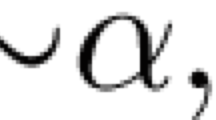Abstract
First-order intuitionistic and classical Nelson–Wansing and Arieli–Avron–Zamansky logics, which are regarded as paradefinite and connexive logics, are investigated based on Gentzen-style sequent calculi. The cut-elimination and completeness theorems for these logics are proved uniformly via theorems for embedding these logics into first-order intuitionistic and classical logics. The modified Craig interpolation theorems for these logics are also proved via the same embedding theorems. Furthermore, a theorem for embedding first-order classical Arieli–Avron–Zamansky logic into first-order intuitionistic Arieli–Avron–Zamansky logic is proved using a modified Gödel–Gentzen negative translation. The failure of a theorem for embedding first-order classical Nelson–Wansing logic into first-order intuitionistic Nelson–Wansing logic is also shown.
Similar content being viewed by others
References
Almukdad, A., & Nelson, D. (1984). Constructible falsity and inexact predicates. Journal of Symbolic Logic, 49(1), 231–233.
Angell, R. (1962). A propositional logics with subjunctive conditionals. Journal of Symbolic Logic, 27, 327–343.
Arieli, O., & Avron, A. (1996). Reasoning with logical bilattices. Journal of Logic, Language and Information, 5, 25–63.
Arieli, O., & Avron, A. (1998). The value of the four values. Artificial Intelligence, 102(1), 97–141.
Arieli, O., & Avron, A. (2016). Minimal paradefinite logics for reasoning with incompleteness and inconsistency. In Proceedings of the 1st International Conference on Formal Structures for Computation and Deduction (FSCD), (Vol. 52 pp. 7:1–7:15). Leibniz International Proceedings in Informatics (LIPIcs).
Arieli, O., & Avron, A. (2017). Four-valued paradefinite logics. Studia Logica, 105(6), 1087–1122.
Arieli, O., Avron, A., & Zamansky, A. (2011). Ideal paraconsistent logics. Studia Logica, 99(1-3), 31–60.
Belnap, N. D. (1977). A useful four-valued logic. In G. Epstein J. M. Dunn (Eds.) Modern uses of multiple-valued logic (pp. 5–37). Reidel: Dordrecht.
Belnap, N. D. (1977). How a computer should think. In G. Ryle (Ed.) Contemporary aspects of philosophy (pp. 30–56). Stocksfield: Oriel Press.
Béziau, J.-Y. (2009). Bivalent semantics for De Morgan logic (The uselessness of four-valuedness). In W.A. Carnieli, M.E. Coniglio, & I.M. D’Ottaviano (Eds.) The many sides of logic (pp. 391–402). College Publications.
Craig, W. (1957). Three uses of the Herbrand-Gentzen theorem in relating model theory and proof theory. Journal of Symbolic Logic, 22(3), 269–285.
Dunn, J. M. (1976). Intuitive semantics for first-degree entailment and ‘coupled trees’. Philosophical Studies, 29(3), 149–168.
Gentzen, G. (1969). In Szabo, M.E. (Ed.), Collected papers of Gerhard Gentzen. North-Holland: Studies in logic and the foundations of mathematics.
Gurevich, Y. (1977). Intuitionistic logic with strong negation. Studia Logica, 36, 49–59.
H. Omori, & H. Wansing (Eds.) (2019). New essays on Belnap-Dunn logic, Synthese Library. Studies in Epistemology, Logic, Methodology, and Philosophy of Science, (Vol. 418 p. 324). Springer.
H. Wansing, H. Omori, & T. M. Ferguson (Eds.) (2016). Special issue: Connexive logics. IfCoLog Journal of Logics and their Applications, 3(3).
Kamide, N. (2011). Notes on Craig interpolation for LJ with strong negation. Mathematical Logic Quarterly, 57(4), 395–399.
Kamide, N. (2017). Extending ideal paraconsistent four-valued logic. Proceedings of the 47th IEEE International Symposium on Multiple-Valued Logic (ISMVL), 2017, 49–54.
Kamide, N. (2019). An extended paradefinte Belnap-Dunn logic that is embeddable into classical logic and vice versa. Proceedings of the 11th International Conference on Agents and Artificial Intelligence (ICAART 2019), 2, 377–387.
Kamide, N. (2020). Kripke-completeness and cut-elimination theorems for intuitionistic paradefinite logics with and without quasi-explosion. Journal of Philosophical Logic, 49 (6), 1185–1212.
Kamide, N., & Shramko, Y. (2017). Embedding from multilattice logic into classical logic and vice versa. Journal of Logic and Computation, 27(5), 1549–1575.
Kamide, N., & Wansing, H. (2012). Proof theory of Nelson’s paraconsistent logic: a uniform perspective. Theoretical Computer Science, 415, 1–38.
Kamide, N., & Wansing, H. (2015). Proof theory of N4-related paraconsistent logics, Studies in Logic. College Publications, 54, 1–401.
Kamide, N., & Zohar, Y. (2019). Yet another paradefinite logic: The role of conflation. Logic Journal of the IGPL, 27(1), 93–117.
Kamide, N., & Zohar, Y. (2020). Completeness and cut-elimination for first-order ideal paraconsistent four-valued logic. Studia Logica, 108(3), 549–571.
Kamide, N., & Zohar, Y. (2020). Modal extensions of ideal paraconsistent four-valued logic and its subsystem. Annals of Pure and Applied Logic, 171(10):102830.
Kripke, S. A. (1965). Semantical analysis of intuitionistic logic I. Studies in Logic and the Foundations of Mathematics, 40, 92–130.
McCall, S. (1966). Connexive implication. Journal of Symbolic Logic, 31, 415–433.
Nelson, D. (1949). Constructible falsity. Journal of Symbolic Logic, 14, 16–26.
Omori, H., & Wansing, H. (2017). 40 years of FDE: an introductory overview. Studia Logica, 105(6), 1021–1049.
Omori, H., & Wansing, H. (2015). A web site on connexive logic, https://sites.google.com/site/connexivelogic/home.
Priest, G. (2002). Paraconsistent logic, Handbook of Philosophical Logic. In D. Gabbay F. Guenthner (Eds.). 2nd edn., (Vol. 6 pp. 287–393). Dordrecht: Kluwer Academic Publishers.
Rautenberg, W. (1979). Klassische und nicht-klassische Aussagenlogik. Braunschweig: Vieweg.
Takeuti, G. (2013). Proof theory, 2nd edn. New York: Dover Publications, Inc. Mineola.
Vorob’ev, N. N. (1952). A constructive propositional calculus with strong negation (in Russian). Doklady Akademii Nauk SSSR, 85, 465–468.
Wansing, H. (1993). The logic of information structures, (p. 681 163). Lecture Notes in Artificial Intelligence.
Wansing, H. (2005). Connexive modal logic. Advances in Modal Logic, 5, 367–385.
Wansing, H. (2020). Connexive logic, Stanford Encyclopedia of Philosophy, http://plato.stanford.edu/entries/logic-connexive/.
Acknowledgements
We would like to thank the anonymous referees for their valuable comments. This research was supported by JSPS KAKENHI Grant Numbers JP18K11171 and JP16KK0007 and Grant-in-Aid for Takahashi Industrial and Economic Research Foundation.
Author information
Authors and Affiliations
Corresponding author
Additional information
Ethical Statement
The authors have no conflict of interest.
Publisher’s Note
Springer Nature remains neutral with regard to jurisdictional claims in published maps and institutional affiliations.
Rights and permissions
About this article
Cite this article
Kamide, N. Embedding Friendly First-Order Paradefinite and Connexive Logics. J Philos Logic 51, 1055–1102 (2022). https://doi.org/10.1007/s10992-022-09659-3
Received:
Accepted:
Published:
Issue Date:
DOI: https://doi.org/10.1007/s10992-022-09659-3



